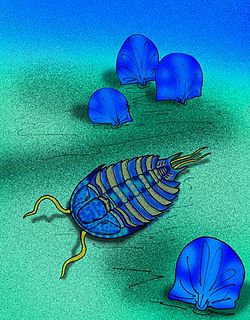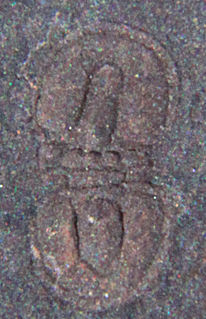Related Research Articles

Trilobites are a group of extinct marine arachnomorph arthropods that form the class Trilobita. Trilobites form one of the earliest-known groups of arthropods. The first appearance of trilobites in the fossil record defines the base of the Atdabanian stage of the Early Cambrian period, and they flourished throughout the lower Paleozoic before slipping into a long decline, when, during the Devonian, all trilobite orders except the Proetids died out. The last extant trilobites finally disappeared in the mass extinction at the end of the Permian about 252 million years ago. Trilobites were among the most successful of all early animals, existing in oceans for almost 300 million years.

Lembit Öpik is a British former politician. A member of the Liberal Democrats, he served as the Member of Parliament (MP) for the constituency of Montgomeryshire in Wales from 1997 until he lost his seat at the 2010 general election. He was the leader of the Welsh Liberal Democrats from 2001 to 2007.

"Guo", written in Chinese: 郭, is one of the most common Chinese surnames and means "the wall that surrounds a city" in Chinese. It can also be transliterated into English as Cok, Gou, Quo, Quek, Keh, Kuo, Kuoch, Kok, Koc, Kwek, Kwik, Kwok, Kuok, Kuek, Gock, Koay, or Ker. The Korean equivalent is spelled Kwak; the Vietnamese equivalent is Quoc, Quach, Quock, or Que. The different ways of spelling this surname indicate the origin of the family. For example, the Cantonese "Kwok" originated in Hong Kong and the surrounding area. It is the 18th most common family name in China and can be traced as far back as the Xia Dynasty. There are eight legendary origins of the Guo surname, which include a Persian (Hui) origin, a Korean origin, and a Mongolian origin, as a result of sinicization. However, the majority of people bearing the surname Guo are descended from the Han Chinese.

The Prix Jacques Le Marois is a Group 1 flat horse race in France open to thoroughbred colts and fillies aged three years or older. It is run at Deauville over a distance of 1,600 metres, and it is scheduled to take place each year in August.

Sinoconodon rigneyi is an ancient mammaliamorph or early mammal that appears in the fossil record of China in the Sinemurian stage of the Early Jurassic period, about 193 million years ago. While in many traits very similar to non-mammalian synapsids, it possessed a special, secondarily evolved jaw joint between the dentary and the squamosal bones, which had replaced the primitive tetrapod one between the articular and quadrate bones, a trait commonly used to define mammals.
The Kaili Formation is a stratigraphic formation which was deposited during the Lower and Middle Cambrian. The formation is approximately 200 metres (660 ft) thick and was named after the city Kaili in the Guizhou province of southwest China.
The following is a list of players, both past and current, who appeared at least in one game for the Los Angeles Dodgers National League franchise (1958–present), and for the Brooklyn-based teams known as the Atlantics (1884), Grays (1885–1887), Bridegrooms, Grooms (1891–1895), Superbas (1899–1910), Dodgers and Robins (1914–1931).
A Dictionary of Canadianisms on Historical Principles (DCHP) is available in a 1967 edition and in a 2017 expanded, updated and partially revised edition. DCHP is a historical usage dictionary of words, expressions, or meanings which are native to Canada or which are distinctively characteristic of Canadian usage though not necessarily exclusive to Canada. The first edition was edited by Walter S. Avis (ed.-in-chief), C. Crate, P. Drysdale, D. Leechman, M. H. Scargill, C. J. Lovell, and published in 1967 by W. J. Gage Limited.
The Prix de Seine-et-Oise is a Group 3 flat horse race in France open to thoroughbreds aged three years or older. It is run at Maisons-Laffitte over a distance of 1,200 metres, and it is scheduled to take place each year in late October or early November.

Calymene blumenbachii, sometimes erroneously spelled blumenbachi, is a species of trilobite discovered in the limestone quarries of the Wren's Nest in Dudley, England. Nicknamed the Dudley Bug or Dudley Locust by 18th-century quarrymen it became a symbol of the town and featured on the Dudley County Borough Council coat-of-arms. Calymene blumenbachii is commonly found in Silurian rocks and is thought to have lived in the shallow waters of the Silurian, in low-energy reefs. This particular species of Calymene is unique to the Wenlock series in England, and comes from the Wenlock Limestone Formation in Much Wenlock and the Wren's Nest in Dudley. These sites seem to yield trilobites more readily than any other areas on the Wenlock Edge, and the rock here is dark grey as opposed to yellowish or whitish as it appears on other parts of the Edge, just a few miles away, in Church Stretton and elsewhere. This suggests local changes in the environment in which the rock was deposited.

Meteoraspis is an extinct genus of ptychopariid trilobites of the family Tricrepicephalidae. The various species lived from 501 to 490 million years ago during the Dresbachian faunal stage of the late Cambrian Period. Fossils of Meteoraspis are characteristic of Late Cambrian strata in North America, though they are found in Late Cambrian strata elsewhere in the world, such as M. nevensis from Victoria Land, Antarctica.
A massively parallel processor array, also known as a multi purpose processor array (MPPA) is a type of integrated circuit which has a massively parallel array of hundreds or thousands of CPUs and RAM memories. These processors pass work to one another through a reconfigurable interconnect of channels. By harnessing a large number of processors working in parallel, an MPPA chip can accomplish more demanding tasks than conventional chips. MPPAs are based on a software parallel programming model for developing high-performance embedded system applications.

Permineralization is a process of fossilization in which mineral deposits form internal casts of organisms. Carried by water, these minerals fill the spaces within organic tissue. Because of the nature of the casts, permineralization is particularly useful in studies of the internal structures of organisms, usually of plants.

The Kope Formation is one of the three component bedrock formations of the Maquoketa Group that primarily consists of shale (75%) with some limestone (25%) interbedded. In general, it has a bluish-gray color that weathers light gray to yellowish-gray and it occurs in northern Kentucky, southwest Ohio, and southeast Indiana, United States.

The Columbus Limestone is a mapped bedrock unit consisting primarily of fossiliferous limestone, and it occurs in Ohio, Pennsylvania, and Virginia in the United States, and in Ontario, Canada.
Acmarhachis is a genus of trilobite in the order Agnostida, which lived in what are now Australia, Canada, China (Anhui), Kazakhstan, Russia (Kharaulakh), and the US. It was described by Resser in 1938, and the type species is Acmarhachis typicalis.

Pentagnostus is a genus of trilobites restricted to the Middle Cambrian. Its remains have been found in Siberia, Australia, North America, Scandinavia, and Kazakhstan.
Christina Lochman-Balk was an American geologist who specialized in the study of Paleozoic era fossils, formerly known as Cambrian Paleontology. Lochman specifically dealt with Cambrian trilobites and invertebrates. During her career, it was not very common for women to pursue degrees or careers in geology, which was studied mostly by men. Along with her research, she also served as a lecturer and professor at the universities Mount Holyoke, University of Chicago and the New Mexico Institute of Mining and Technology. She received two degrees from Smith College in Northampton, Massachusetts in Geology, and her doctorate at Johns Hopkins University in 1933. She married Robert Balk in 1947, who was a geology professor at the University of Chicago. Following her husband's death in 1955, she became a full professor as well as appointed head of the geology department of the New Mexico Institute of Mining and Technology in 1957. She retired from her position in 1972.
References
| This Agnostida-related article is a stub. You can help Wikipedia by expanding it. |